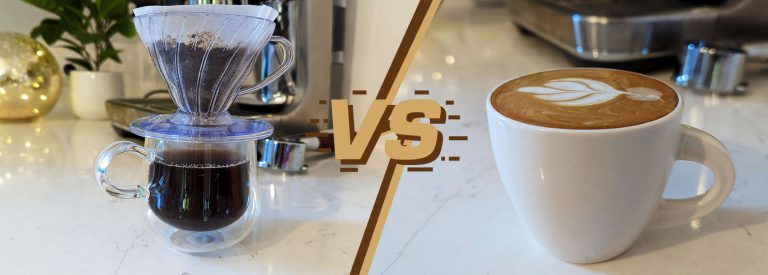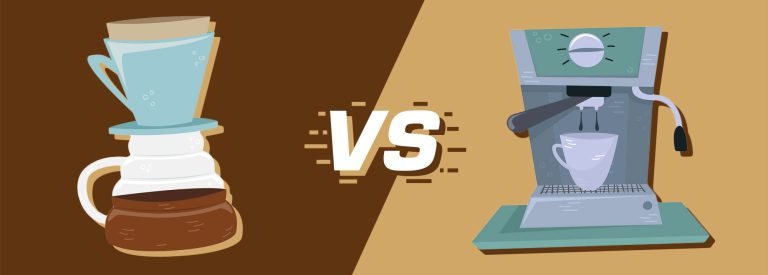Lungo vs Latte: An In-Depth Comparison of Two Coffees
With the long list of coffee drinks you can choose from in a cafe, it’s no wonder it can get confusing, especially for new coffee enthusiasts.
But no worries, I’ll share with you the distinct features of these drinks that set them apart from each other, from their ingredients and ratios to their recipes and flavors.
And let me tell you, they’re very different, so let’s start.
Key takeaway: What’s the difference between a Latte and a Lungo?
The Lungo is a unique variation of espresso, having a coffee-to-water ratio of 1:4 – 1:5, revealing a strong, somewhat bitter flavor which is less concentrated than traditional espresso. On the other hand, a Latte blends 1 part (or 2) espresso with 3-6 parts milk, creating a creamy, mild flavor profile that is harmoniously tempered by the milk’s sweetness and creaminess. While the Lungo offers a bolder yet milder alternative to classic espresso, the Latte provides a smooth and velvety coffee experience
What is Lungo?
Originating from the Italian word for “long”, Lungo is a unique variation of espresso with a longer extraction time. More water is passed through a bed of coarser ground coffee, which results in a milder cup compared to the traditional espresso. This method is actually quite popular, especially in Europe.

The Lungo has a coffee-to-water ratio of 1:4 – 1:5. Traditional Italian styles use 7 g of ground coffee per shot, while the third-wave specialty coffee requires about 9g.
When served, the Lungo is usually around 2 oz (60 ml) in size, depending on which café you’re in. It’s best enjoyed in a larger demitasse, one with a capacity of about 90 milliliters (3 US fl oz). You don’t need anything larger, since it is way shorter than a cup of drip coffee.
Each serving contains 60-80 mg of caffeine and just 2 calories per shot. Just because you let it longer, you don’t increase the caffeine content.
A sip of Lungo reveals a strong, somewhat bitter flavor, though it’s less concentrated than a classic espresso. The texture sits between an espresso and an Americano, offering a balanced mouthfeel that is both rich and fluid. If you’re looking for something intense but not as overpowering as an espresso, Lungo might just be your go-to. Take note though that this could be too bitter for your taste.
I’ve found that the best way to make a lungo is not to simply let the espresso run longer, since that causes bitterness. It’s better to coarsen up your grinds a bit, to keep an extraction time of around 30-35 seconds, but still get the larger volume.
Here’s a quick guide on making a Lungo:
- Grind coffee beans using a setting slightly coarser than espresso grinds.
- As you brew your Lungo, use a timer and scale to measure your yield.
- Stop brewing after around 35 seconds, targeting a 1:4 to 1:5 coffee-to-water ratio.
For a more comprehensive guide, you can check out my step-by-step recipe on how to make a Lungo.
Now let’s check out what the latte is all about.
What is a Latte?
The Caffé Latte, often simply referred to as latte, is an espresso-based drink that has been around since the 1980s. Its name, “caffé e latte”, is Italian for “coffee and milk”— a plain but accurate description of the drink. The latte has become super popular with the rise of coffee chains like Starbucks.

Over the years, its balance of flavors and the artistry of latte art designs on the microfoam have made this drink a favorite among many coffee drinkers.
A latte consists of 1 part espresso mixed with 3-6 parts milk, topped with a thin microfoam layer. For the traditional espresso, baristas use the 1:2 to 1:3 brew ratio with 7g of ground coffee for a single shot and 14g for a double. I use a bit more, about 9g for a single shot and 18g for a double for third-wave specialty coffee.
The serving of a latte ranges from 5 to 16 oz (150 to 480 ml), but the larger end of this spectrum is not served at specialty cafés, only Starbucks and the like. I enjoy mine in a latte mug which has a capacity of 240-300 ml (8-10 oz). Like the lungo, each espresso shot used in a serving has 60-80 mg of caffeine.
The latte has 2 calories per shot of espresso, plus 18 calories per 1 oz (30 ml) of whole milk. For a standard 240 ml latte, you’re looking at around 128 calories. While whole milk is a staple in Iattes, I also suggest that you try out alternatives like soy, almond, or oat milk. I like using soy because of the distinct taste it has 🙂
The Café Latte is creamy and mild in taste, since the espresso’s boldness is harmoniously tempered by the milk’s sweetness and creaminess. Its texture is smooth and velvety, with the frothy milk layer on top adding a special touch to the final drink. You can even add whipped cream on top, making it a sweet indulgent treat.
Here are the steps to craft a delicious Latte:
- Prepare either a single or double espresso.
- Fill cold milk into a steaming pitcher up to the spout’s bottom.
- Steam the milk till it’s around 160 degrees Fahrenheit, aerating to achieve a silky texture with microfoam.
- Gently pour the steamed milk over your espresso.
- Top it off with your best latte art.
Making lattes can be confusing on your first few tries. To make it easier, I have written an in-depth guide on how to make a Caffé Latte.
Lungo vs Latte: The Similarities and Differences
Let’s simplify things with this side-by-side comparison of Lungo and latte:
| Aspect | Lungo | Latte |
|---|---|---|
| Taste and Texture | Strong, somewhat bitter, rich and fluid | Creamy and mild, smooth and velvety |
| Coffee-to-Water Ratio | 1:4 – 1:5 | Espresso in latte: 1:2 to 1:3 |
| Ingredient Ratio | Just coffee with more water than an espresso | 1 part espresso, 3-6 parts milk, & thin microfoam layer |
| Typical Serving Size | 2 oz (60 ml) | 5 to 16 oz (150 to 480 ml) |
| Caffeine Content | 60-80 mg per single shot | 60-80 mg per 1 oz shot of espresso used |
| Calories | 2 calories per shot | 2 calories per shot of espresso + milk calories |
| Acidity | Moderate | Low to moderate |
| Brewing Difficulty | Intermediate | Home barista |
| Bean Roast | Light to medium roasts | Medium roasts; dark roasts can also work |
Now, let’s compare the defining factors of these beverages:
- Ground Coffee Weight & Ratios: Like an espresso, the Lungo uses 7g (traditional Italian) or 9g (third-wave specialty) of ground coffee but with a 1:5 coffee-to-water ratio.
Latte also uses the same amount of grounds but follows the espresso’s standard 1:2 to 1:3 ratios. One part espresso is then combined with 3-6 parts of steamed milk with a thin microfoam. - Taste: Lungo, essentially a “long espresso”, retains a strong, somewhat bitter flavor. Its texture is between that of an espresso and an Americano, making it intense yet not overpowering.
Contrasting this is the latte’s creamy, mild flavor with the espresso’s boldness softened by the milk’s sweetness. Its texture is smooth and velvety. - Volume, Calories, & Caffeine: A Lungo’s serving is 2 oz with 2 calories per shot and 60-80 mg of caffeine. While the latte maintains the same caffeine content, it has more volume at 5-16 oz and a caloric count of 128 calories per 240 ml because of the milk.
- Bean Roast: For Lungos, I use light to medium roasts to help balance the slightly bitter flavor. For lattes, I lean towards medium roasts to harmonize with the milk, though dark roasts can also add a bold twist.
- Steamed Milk: Lattes combine 1 part espresso with 3-6 parts steamed milk and a thin layer of microfoam, which can be dairy or plant-based alternatives like soy or almond. You can read my guide on how to steam milk for your latte.
- Serving Suggestions: I don’t drink Lungo that much because of the bitterness, or having to dial in a coarser grind size. If I want a milder espresso, I go for an Americano instead. Milk-infused espresso drinks also work for me, just like a latte that I whip up with soy milk.
As you can see, both drinks are prepared with an espresso machine, but their flavors couldn’t be any more different.
If you want to get the best results when pulling your espresso shots, check out my list of the best espresso coffee beans this 2024.
Or if you don’t have an espresso machine, here are 7 ways to make an espresso at home.
Conclusion
Like I said, I’m not a big fan of Lungo. So if I were to pick from the two drinks, I’d go for the latte. I like its warming and comforting effect, especially on lazy weekends at a café, when I can take the time to enjoy my cup of coffee.
But that’s just my taste, some people like the Lungo. How about you, which coffee drink do you like better? Let me know in the comments section below.








 900ML Cold Brew Coffee Maker with Filter
900ML Cold Brew Coffee Maker with Filter  Double Spouted 2-Cup Moka Pot
Double Spouted 2-Cup Moka Pot  Electric Turkish Coffee Pot
Electric Turkish Coffee Pot  Ceramic Curved Espresso Dosing Cup and Spray Kit
Ceramic Curved Espresso Dosing Cup and Spray Kit  MHW-3BOMBER Digital Instant Read Coffee Thermometer
MHW-3BOMBER Digital Instant Read Coffee Thermometer  Stainless Steel Portafilter Rack
Stainless Steel Portafilter Rack